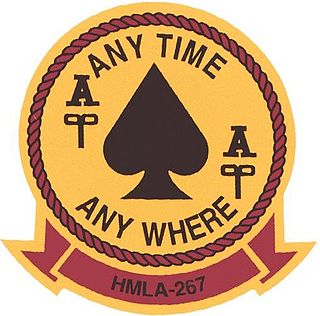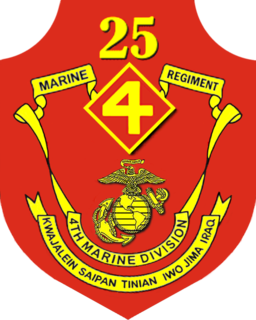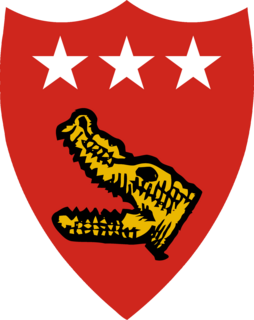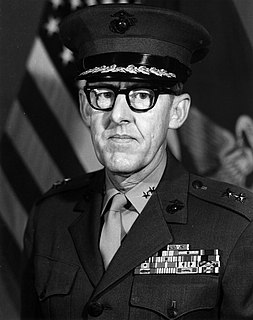
The Battle of Iwo Jima was a major battle in which the United States Marine Corps (USMC) and United States Navy (USN) landed on and eventually captured the island of Iwo Jima from the Imperial Japanese Army (IJA) during World War II. The American invasion, designated Operation Detachment, had the purpose of capturing the island with its two airfields: South Field and Central Field.

Michael Strank was a United States Marine Corps sergeant who was killed in action during the Battle of Iwo Jima in World War II. He was one of the Marines who raised the second U.S. flag on Mount Suribachi on February 23, 1945, as shown in the iconic photograph Raising the Flag on Iwo Jima by photographer Joe Rosenthal. Of the six Marines depicted in the photo, Strank was the only one to be correctly identified from the beginning; the other five were either assigned the wrong locations, or, were given the names of Marines who were not in the photo.

The 3rd Marine Division is a division of the United States Marine Corps based at Camp Courtney, Marine Corps Base Camp Smedley D. Butler and Okinawa, Japan. It is one of three active duty infantry divisions in the Marine Corps and together with the 1st Marine Aircraft Wing (1stMAW) and the 3rd Marine Logistics Group forms the III Marine Expeditionary Force. The division was first formed during World War II and saw four years of continuous combat in the Vietnam War. Today, elements of the 3rd Marine Division are continuously forward deployed and forward postured to carry out the US Government's mission of a Free and Open Indo-Pacific in conjunction with its sister services.

The 5th Marine Division was a United States Marine Corps ground combat division which was activated on 11 November 1943 at Camp Pendleton, California during World War II. The 5th Division saw its first combat action during the Battle of Iwo Jima in 1945 where it sustained the highest number of casualties of the three Marine divisions of the V Amphibious Corps. The 5th Division was to be part of the planned invasion of the Japan homeland before Japan surrendered. Assault troops of the 5th Division were included in the Presidential Unit Citation awarded to the V Amphibious Corps for extraordinary heroism on Iwo Jima from 19 to 28 February 1945. The 5th Division was deactivated on 5 February 1946.

Marine Light Attack Helicopter Squadron 267 (HMLA-267) is a United States Marine Corps helicopter squadron consisting of Bell AH-1Z Viper attack helicopters and Bell UH-1Y Venom utility helicopters. Nicknamed the "Stingers", the squadron is based at Marine Corps Base Camp Pendleton, California and falls under the command of Marine Aircraft Group 39 (MAG-39) and the 3rd Marine Aircraft Wing.

The 25th Marine Regiment is one of two infantry regiments in the 4th Marine Division of the United States Marine Corps. From its headquarters in Fort Devens, Massachusetts, the regiment commands fifteen training centers in nine states throughout the Northeast. These units consist of approximately 3,500 reserve and active duty Marines and are located from Maine to Delaware, West Virginia and as far west as Ohio. The 25th Marines is primarily a cold weather regiment and frequently trains in northern Norway.

2nd Battalion, 14th Marines (2/14) is a reserve artillery battalion comprising three firing batteries and a headquarters battery. The battalion headquarters is in Grand Prairie, Texas. In 2006 the battalion became the first fully operational HIMARS battalion in the Marine Corps. Fox Battery, based in Oklahoma City, Oklahoma. was deployed in July 2007 in support of Operation Iraqi Freedom, and has the distinction of being the first Marine Corps HIMARS battery to deploy into combat.

On 15 June 1944, United States Marine forces landed on the southwest coast of the island of Saipan in the central Marianas chain; these were followed a day later by US Army forces. This invasion was part of Operation Forager, an effort to recapture the entire Marianas chain from the Empire of Japan.

The 9th Marine Regiment was an infantry regiment of the United States Marine Corps. Formed during World War II, it served until 1994, when it was deactivated during the post Cold War drawdown. Battalions of the Ninth Marine Regiment, but not the regiment itself, were reactivated from 2007 to 2014 as part of the Marine Corps' growth during the wars in Iraq and Afghanistan. The battalions have subsequently been deactivated again.

Tony Stein was a United States Marine who posthumously received the U.S. military's highest decoration, the Medal of Honor, for his actions in World War II. He received the award for repeatedly making single-handed assaults against the enemy and for aiding wounded Marines during the initial assault on Iwo Jima on February 19, 1945. He was killed in action ten days later.

The 27th Marine Regiment is an inactivated infantry regiment of the United States Marine Corps. They fought during the battle of Iwo Jima in World War II and again for a short time during the Vietnam War.

The 3rd Battalion, 9th Marines (3/9) is an infantry battalion of the United States Marine Corps. Formed during World War I it served until the early 1990s when it was redesignated as 3rd Battalion, 4th Marines (3/4) during a realignment and renumbering of the Marine Corps' infantry battalions, following the deactivation of the 9th Marine Regiment. The 3rd Battalion, 9th Marines was initially a subordinate unit of the 9th Marine Regiment, 3rd Marine Division, but was later operationally transferred to the 1st Marine Division as a subordinate unit of the 7th Marine Regiment where it remained until its redesignation as 3/4.

The 26th Marine Regiment is an inactivated infantry regiment of the United States Marine Corps. The 26th Marines were activated in 1944 and fought in the Battle of Iwo Jima during World War II and were activated again on 1 March 1966, and fought in the Battle of Khe Sanh during the Vietnam War.

The 28th Marine Regiment is an infantry regiment of the United States Marine Corps. The regiment which is part of the 5th Marine Division, fought in the Battle of Iwo Jima during World War II. Six Marines of the 2nd Battalion, 28th Marines were featured in the historical photo by Joe Rosenthal of the U.S. flag raising on top of Mount Suribachi.

The 2nd Battalion, 28th Marine Regiment is an infantry battalion of the United States Marine Corps. The battalion which is part of the 28th Marine Regiment, 5th Marine Division, fought in the Battle of Iwo Jima during World War II. Six Marines of E Company, 2nd Battalion, 28th Marines were featured in the historical photo by Joe Rosenthal of the U.S. flag raising on top of Mount Suribachi.
Harold George Schrier was a United States Marine Corps lieutenant colonel who served in World War II and the Korean War. In World War II, he was awarded the Navy Cross for leading the patrol that captured the top of Mount Suribachi, where he helped raise the first U.S. flag on Iwo Jima on February 23, 1945. In the Korean War, he was wounded in North Korea during the Battle of Chosin Reservoir while commanding a rifle company.

The 3rd Tank Battalion was an armor battalion of the United States Marine Corps.

The V Amphibious Corps (VAC) was a formation of the United States Marine Corps which was composed of the 3rd, 4th and 5th Marine Divisions in World War II. The three divisions were the amphibious landing force for the United States Fifth Fleet with two goals, removal of Japanese forces from islands so U.S. Seabees could build advance bases to project US power. In doing this VAC was notably involved in the battles for Tarawa, Saipan, and Iwo Jima. V Amphibious Corps was commanded by General Holland 'Howlin Mad' Smith followed by General Harry Schmidt.
The 3rd Battalion 28th Marines (3/28) is an inactive infantry battalion of the United States Marine Corps. They were part of the 28th Marine Regiment and 5th Marine Division and fought during the Battle of Iwo Jima in World War II. They were activated again for the Vietnam War but were deactivated after the war and remain inactive today.

Fred Elmer Haynes Jr. was a United States Marine Corps major general who served in World War II and the Vietnam War. He completed his Marine Corps career as deputy chief of staff for Research, Development and Studies at Headquarters Marine Corps. He was the older brother of actor and Dallas television personality, Jerry Haynes aka Mr. Peppermint, and uncle of musician & artist Gibby Haynes.


















